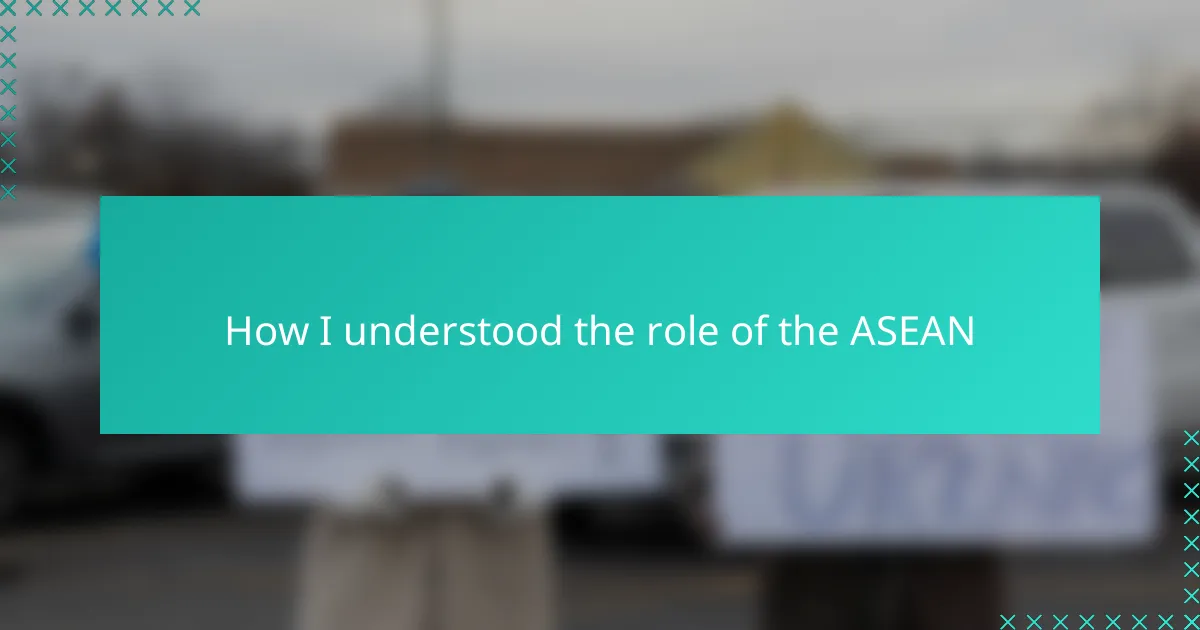Key takeaways
- ASEAN plays a crucial role in global politics by fostering diplomatic dialogue and balancing the interests of diverse member nations amid major powers like the US and China.
- Its principles of consensus, non-interference, and collaborative security approaches help maintain regional stability and prevent conflicts, demonstrating the effectiveness of patience in diplomacy.
- ASEAN’s economic initiatives enhance market integration, attract foreign investment, and empower small businesses, positioning Southeast Asia as a resilient player in the global economy.
- Engagement within ASEAN is built on personal trust and inclusivity, highlighting the importance of relationships in effective diplomacy beyond formal structures.
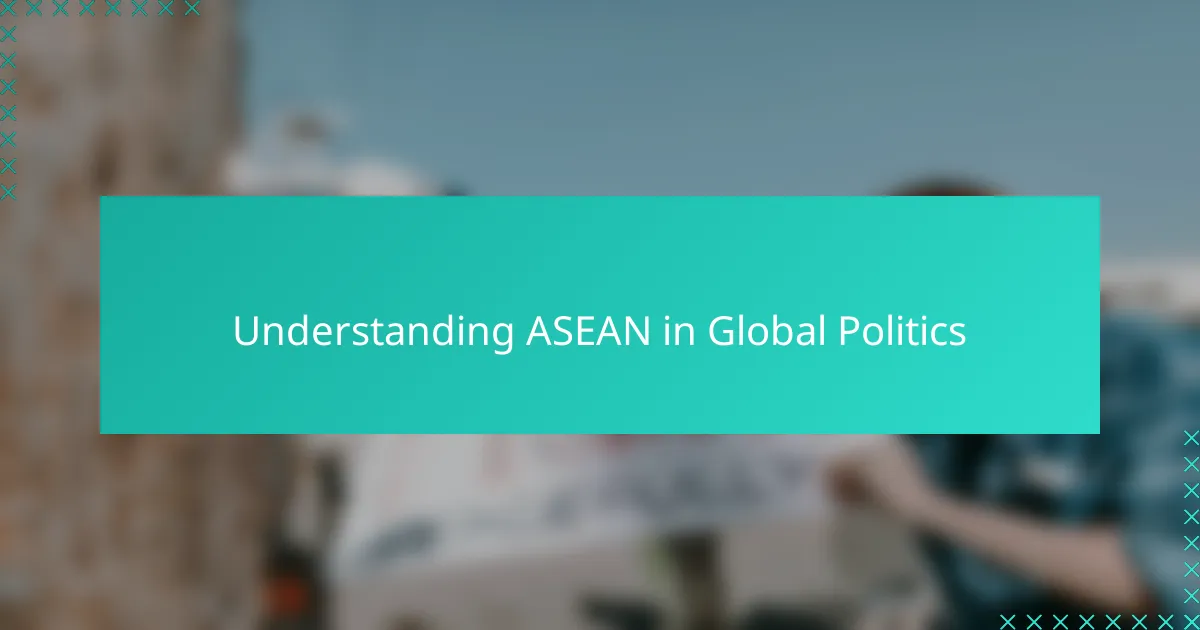
Understanding ASEAN in Global Politics
I used to see ASEAN as just a regional group, but understanding its role in global politics changed my perspective completely. It’s fascinating how this organization manages to balance the interests of ten diverse nations while influencing major geopolitical dynamics. Have you ever wondered how a regional bloc can sway global economic and security conversations?
From my experience, ASEAN’s principle of consensus and non-interference often seems slow-paced compared to Western decision-making, yet it fosters a unique diplomatic space where dialogue prevails over confrontation. This approach may frustrate some, but I find it quite insightful—showing that patience and respect for sovereignty can build stability in a complex region.
What stood out to me most is ASEAN’s strategic position between major powers like the US and China. It’s like watching a delicate dance where ASEAN nations assert their sovereignty while navigating powerful external pressures. This underscores how ASEAN isn’t just a passive observer but an active player shaping regional and global outcomes.
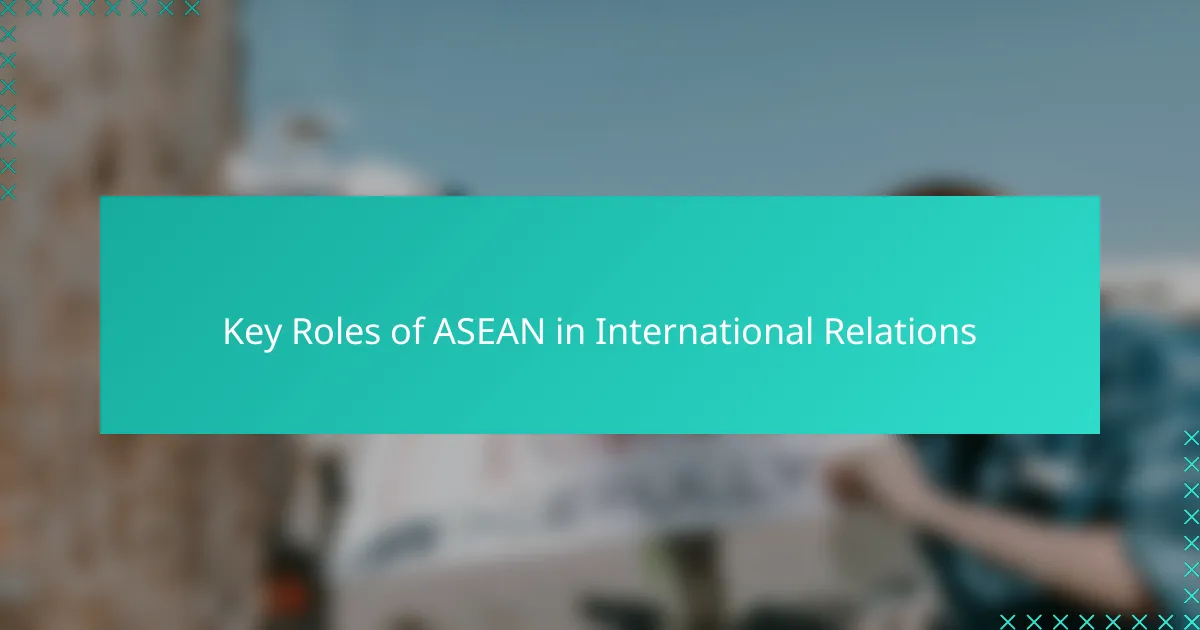
Key Roles of ASEAN in International Relations
When I first delved deeper, I realized ASEAN’s role in international relations goes beyond regional concerns—it’s actually a critical mediator in broader geopolitical tensions. Have you noticed how ASEAN convenes rival powers around the same table? That diplomatic skill struck me as a real strength, creating room for dialogue rather than conflict.
ASEAN also plays a key economic role that often flies under the radar. Its initiatives, like the ASEAN Economic Community, aim to integrate markets and boost trade across Southeast Asia. From what I’ve observed, this economic cohesion makes the region more resilient and attractive to global investors, even amid global uncertainties.
Security cooperation within ASEAN surprised me the most. Instead of military alliances, the focus is on joint responses to challenges like maritime disputes and transnational crime. I think this unconventional approach reflects ASEAN’s belief in collaboration over confrontation, which feels especially relevant in today’s fractured world.
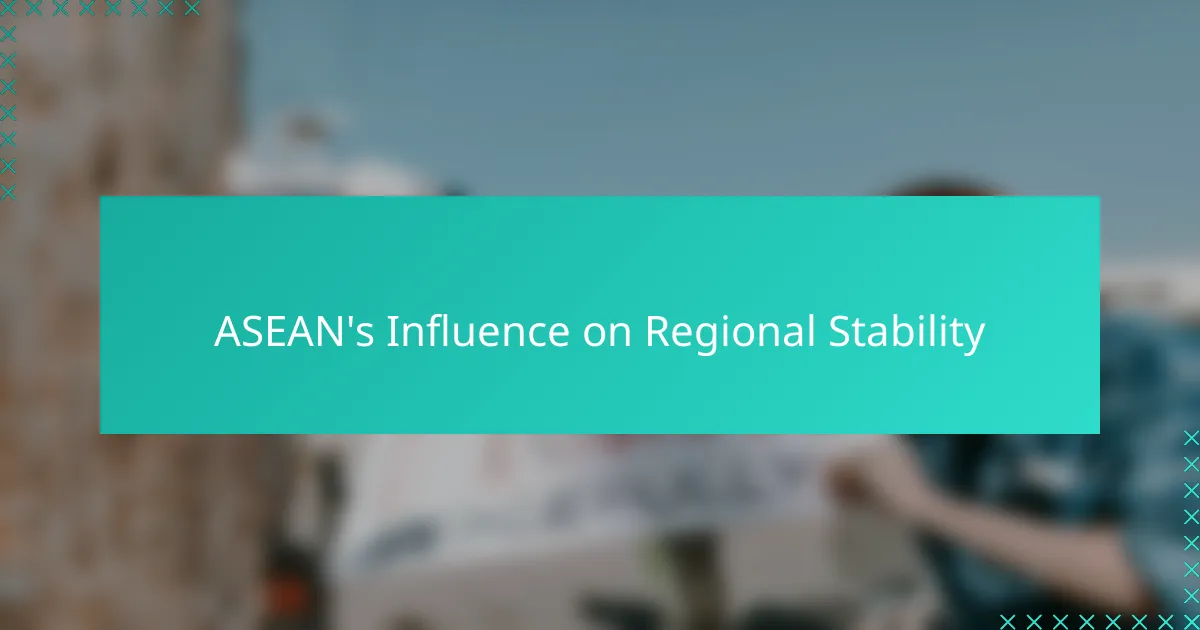
ASEAN’s Influence on Regional Stability
ASEAN’s influence on regional stability became clearer to me when I saw how it consistently acts as a platform for dialogue, even amid rising tensions. Have you ever noticed how conflicts in Southeast Asia rarely escalate into open confrontations? I believe this is largely because ASEAN’s emphasis on calm communication and mutual respect creates a buffer that tempers potential crises.
One thing that really struck me is how ASEAN manages to hold together countries with such diverse political systems and interests without forcing unity. It’s like watching a careful balancing act that prioritizes peace over power. From my perspective, this ability to maintain cohesion in a complicated neighborhood is a quietly powerful form of stability, often overlooked in mainstream discussions.
I also came to appreciate how ASEAN’s forums and cooperative mechanisms provide a space to address security threats collectively, without resorting to military posturing. For instance, tackling issues like piracy and human trafficking together strengthens trust among member states. Isn’t it encouraging to see diplomacy and practical collaboration taking center stage in such a volatile region? That approach, I think, is what truly underpins ASEAN’s lasting impact on regional stability.
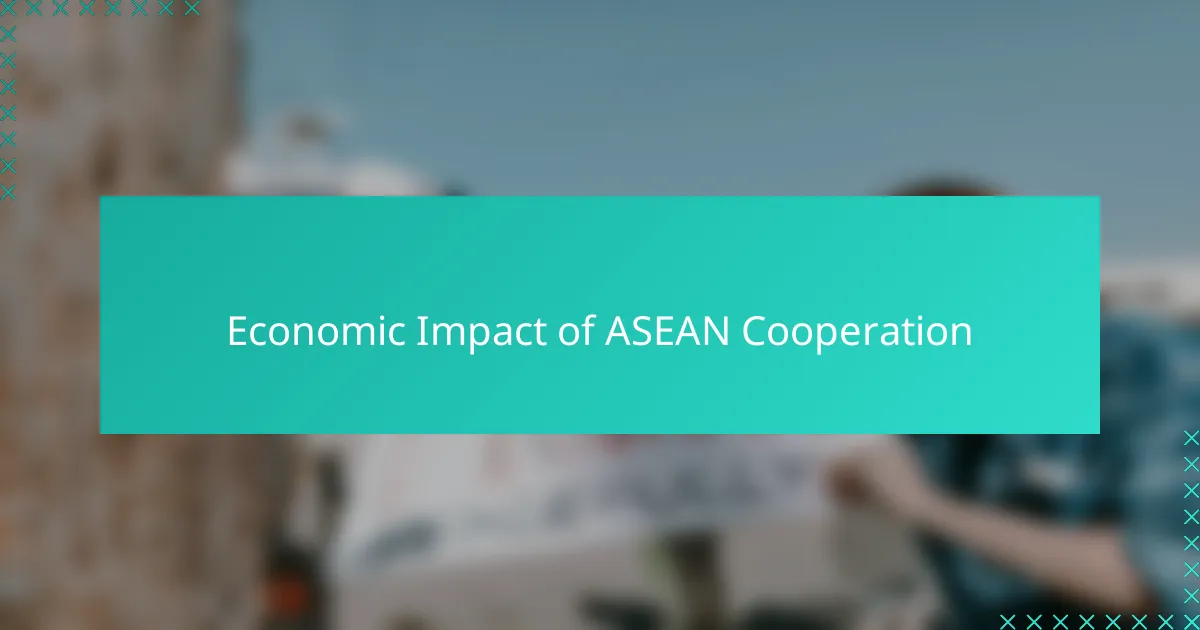
Economic Impact of ASEAN Cooperation
What really opened my eyes about ASEAN’s economic impact was seeing how its cooperation creates a single market that’s much bigger than any one nation alone. Have you ever thought about the power of removing trade barriers among ten countries? That integration not only streamlines business but sparks innovation and competition that benefits everyone in the region.
From my perspective, the ASEAN Economic Community’s efforts to harmonize regulations and improve connectivity feel like laying down the tracks for a high-speed economic train. I remember reading about small and medium enterprises gaining access to new markets without drowning in paperwork—this is where theory meets real-life economic empowerment. Isn’t it impressive how those practical changes ripple out to strengthen Southeast Asia’s position in the global economy?
But it’s not just about trade; ASEAN’s cooperation also attracts foreign investment by offering a more predictable and stable business environment. In my experience, investors value that collective strength, especially amid global uncertainty. When ASEAN acts as one, it sends a powerful message: this region is open for business and ready to grow together.

Personal Insights on ASEAN Engagement
Engaging with ASEAN on a professional level revealed to me how personal relationships and trust underpin much of its diplomacy. I recall attending a regional forum where informal conversations over coffee seemed to open more doors than official meetings ever could. Doesn’t that make you wonder how much of international politics actually happens beyond the headlines?
What intrigued me further was ASEAN’s commitment to inclusivity—even the smallest member states have a voice that counts. From my encounters, this equal footing fosters a sense of community that’s rare in geopolitics. Could it be that this genuine respect among members is the secret sauce to ASEAN’s longevity and influence?
Finally, I’ve seen firsthand how ASEAN’s patient approach sometimes tests the limits of urgency, especially when quick decisions are needed. Yet, once consensus is reached, the shared ownership feels much stronger. It made me reflect: maybe the slow and steady path is a deliberate choice rather than a flaw, carefully designed to cultivate lasting partnerships over temporary wins.
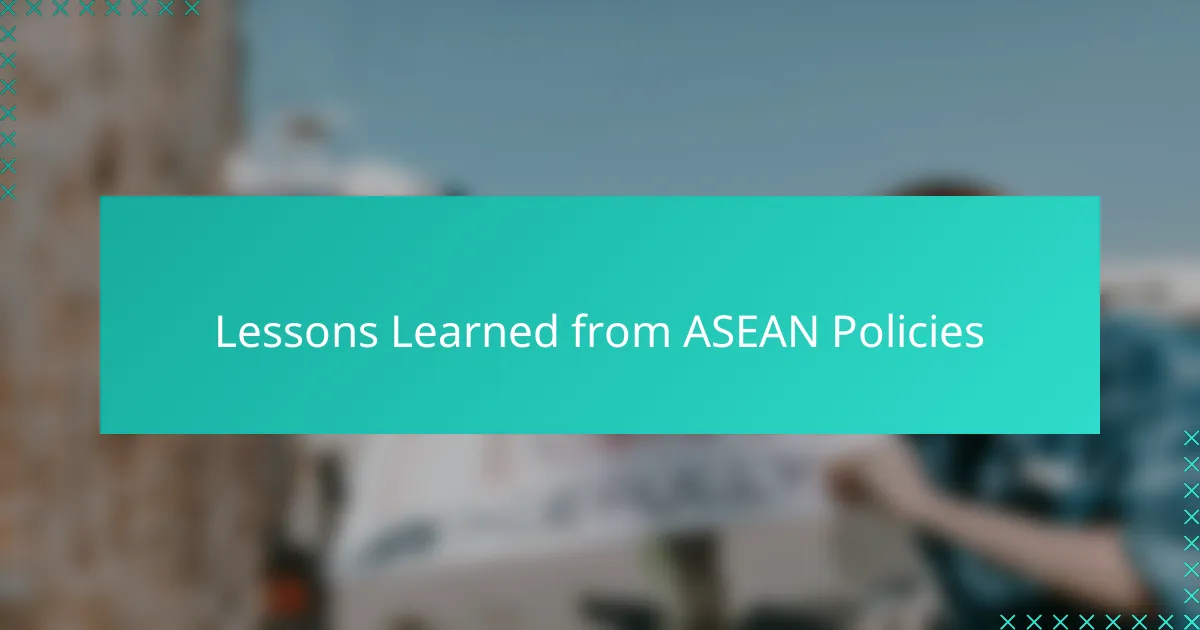
Lessons Learned from ASEAN Policies
One lesson I drew from ASEAN’s policies is the power of patience and consensus in diplomacy. Early on, I found myself frustrated by how slowly ASEAN often moves, but over time, I realized this deliberate pace allows for more durable agreements. Have you noticed how quick decisions sometimes unravel later? ASEAN’s method shows me that taking time to build true consensus avoids that pitfall.
I also learned that respecting sovereignty above all else isn’t just about principle—it’s a practical way to maintain peace among very different nations. I remember thinking, wouldn’t it be easier if ASEAN just imposed uniform policies? But that would probably backfire. Instead, their policy of non-interference nurtures a stable environment where even tense disputes rarely explode. That patience and respect really stood out to me.
Finally, ASEAN’s approach to regional challenges taught me that cooperation doesn’t need to mirror Western models of alliances or forceful interventions. When I saw how ASEAN tackles issues like maritime security through dialogue and joint efforts, it reminded me that collaboration can thrive without confrontation. Doesn’t that give you hope that even complex regions can find peaceful solutions through shared understanding?
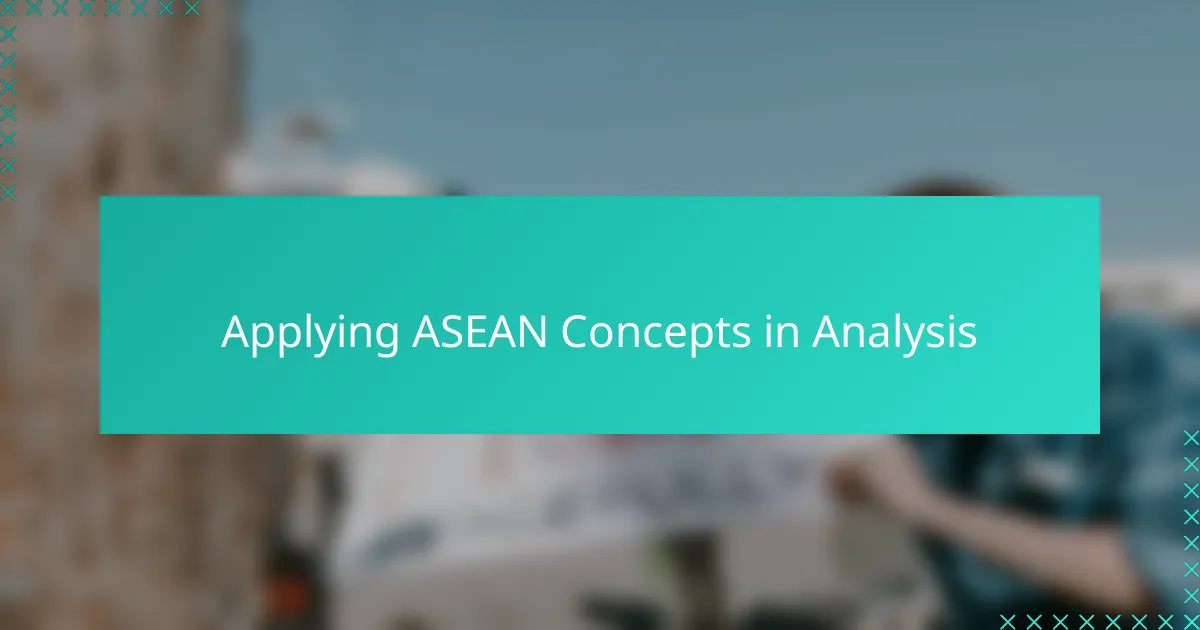
Applying ASEAN Concepts in Analysis
Applying ASEAN concepts in analysis means appreciating the value of patience and consensus-building. At first, I struggled with how slow and cautious ASEAN’s decision-making seemed, but then I realized that this very approach creates lasting agreements rather than fleeting compromises. Have you ever experienced a rushed decision falling apart? ASEAN’s model taught me that taking time to listen and align diverse interests can be much more effective.
Another thing I find fascinating is how respecting sovereignty shapes analytical frameworks. Instead of forcing uniform solutions, ASEAN’s non-interference principle encourages understanding each member’s unique context. In my own work, this reminded me to avoid one-size-fits-all judgments and instead look for subtle negotiations happening beneath the surface. Doesn’t that shift your perspective on regional dynamics?
Finally, applying ASEAN concepts also means recognizing diplomacy beyond formal structures. I remember attending an ASEAN-related event where informal chats and trust-building seemed more influential than official statements. This showed me that analyzing ASEAN requires attention to relationships and intangibles, not just policy texts. Isn’t it interesting how much power quiet diplomacy holds in global politics?
